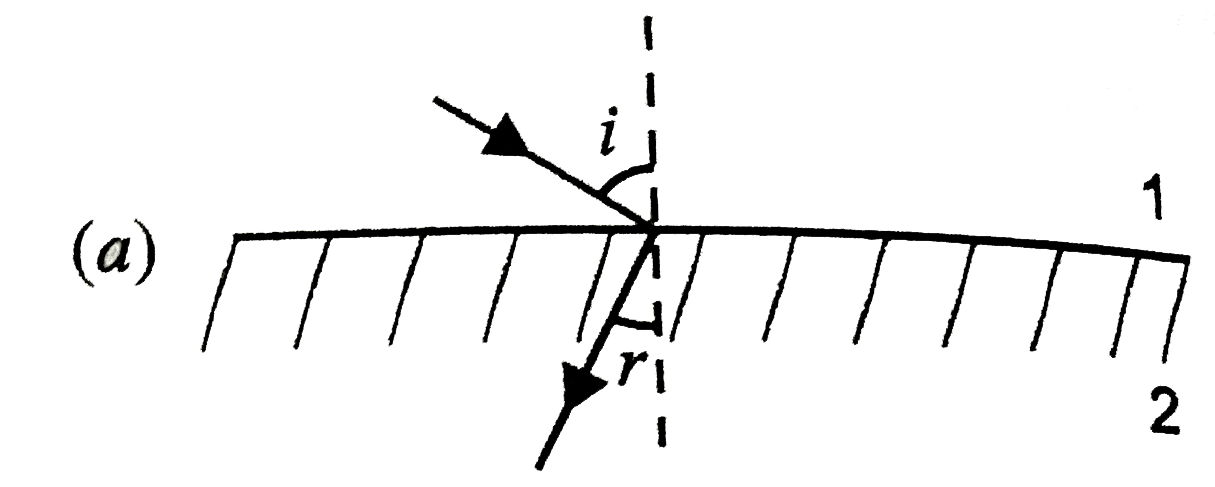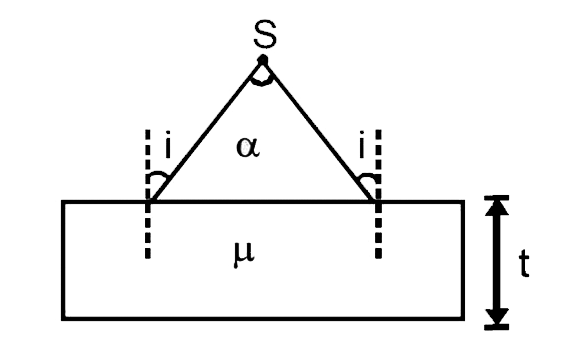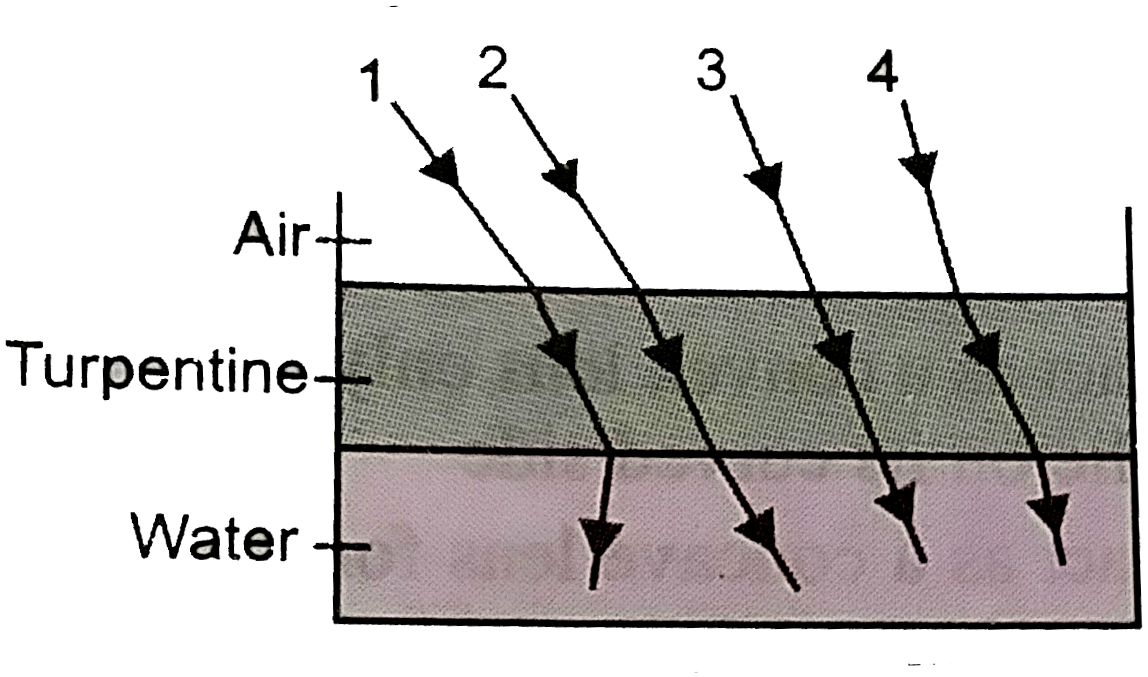Complete Solutions to Exercise of chapter RAY OPTICS of Class 12 book with complete answers and questions
| Class 12 | PHYSICS |
| Chapter | RAY OPTICS |
| DC PANDEY NEET | Exercise |
| Number Of Questions | 100 |
| Academic Year | 2023-24 |
When light is passed through a prismm when………colour shows maximum deviation.
View SolutionWhen the power of eye lens increases, the defect of vision is produced. The defect is known as
View SolutionIn human eye the focussing is done by
View SolutionThe phenomena involved in the reflection of radiowaves by ionosphere is similar to
View SolutionA passenger in an aeroplane shall
View SolutionMyopia is due to
View SolutionThe minimum magnifying power of an astronomical telescope is M. If the focal length of its eye-lens is halved, the minimum magnifying power will become:
View SolutionWhen light wave suffers reflection at the interface from air to glass, the change in phase of the reflected wave is equal to
View SolutionA man has a height of 6m. He observes image of 2m height erect, then mirror used is
View SolutionThe field of view is maximum for
View SolutionA virtual image larger than the object can be obtained by
View SolutionThere are certain materials developed in laboratories which have a negative refractive index, Fig. A ray incident from air (medium 1) into such a medium (medium 2) shall follow a path given by
 .
.
View SolutionHuman eyes are most sensitive to the wavelength of
View SolutionThe reason for shining of air bubble in water is
View SolutionWhat will be the colour of sky as seen from the earth, if there were no atmosphere
View SolutionA short pulse of white light is incident from air to a glass slab at normal incidence. After travelling through the slab, the first colour to emerges is
View SolutionWhich of the following can form a virtual,erect and magnified image?
View SolutionThe sky would appear red instead of blue if
View SolutionA ray of light is incident on the surface of seperation of a medium at an angle `45^(@)` and is refracted in the medium at an angle `30^(@)`. What will be the velocity of light in the medium?
View SolutionWhich of the following quantities increase when wavelength of light is increased? Consider only the magniutude
View SolutionSun is visible a little before the actual sunrise and until a little after a actual sunset. This is due to
View SolutionIn opticle fibres,the refractive index of the core is
View SolutionAn object approaches a covergent lens from the left of the lens with a uniform speed `5 m s^(-1)` and stops at the focus. The image.
View SolutionA point object is placed at the center of a glass sphere of radius 6cm and refractive index 1.5. The distance of virtual image from the surface is
View SolutionAn object has image thrice of its original size when kept at `8 cm` and `16 cm` from a convex lens. Focal length of the lens is
View SolutionIf there had been one eye of the man, then
View SolutionA transparent plastic bag filled with air forms a concave lens. Now, if this bag is completely immersed in water, then it behaves as
View SolutionA normal eye is not able to see objects closer than 25 cm because
View SolutionA mark at the bottom of a liquid appears to rise by `0.1m`. The depth of the liquid is `1m`. The refractive index of the liquid is
View SolutionUnder minimum deviation condition in a prism, if a ray is incident at an angle `30^(@)`, the angle between the emergent ray and the second refracting surface of the prism is
View SolutionA prism can have a maximum refracting angle of `(theta_C=`critical angle for the material of prism )
View SolutionYou are given four sources of light each one providing a light of a single colour-red, blue,green and yellow. Suppose the angle of refraction for a beam of yellow light corresponding to a particular angle of incidence at the interface of two media is `90^@`. Which of the folowing statements is correct it the source of yellow light is replaced with that of other lights without changing the angle of incidence ?
View SolutionA beam of light composed of red and green rays is sincident obliquely at a point on the face of a retangular glass slab When coming out on the opposite parallel face, the red an green rays emerge from
View SolutionObject is placed 15 cm from a concave mirror of focal length 10 cm, then the nature of the image formed will be
View SolutionWhen a lens of refractive index `n_(1)`, then the lens looks to be dissapeared only, if
View SolutionIf `x_(1)` is the size of the magnified image and `x_(2)` is the size of the diminsghed image in lens displacement method, then the size of the object is
View SolutionMark the correct one.
View SolutionThe direction of ray of light incident on a concave mirror is shown by `PQ` while directions in which the ray would travel after reflection is shown by four rays marked `1,2,3` and `4`, Fig. Which of the four rays correctly shows the direction of reflected ray ?
 .
.
View SolutionTwo beam of red and violet color are made to pass separately through a prism (angle of the prism is `60^(@)`). In the positionof minimum deviationi, the angle of refraction will be
View SolutionWhen sun light is scatterred by minute particles of atmosphere, then the intensity of light scattered away is proportional to
View SolutionAn object is placed at a distance u from an equiconvex lens such that the distannce between the object and its real image is minimum. The focal length of the lens is f. The value of u is
View SolutionIf the aperature of a telescope is decreased resolving power will
View SolutionA telescope has an objective of focal length 100 cm and an eye-piece of focal length 5 cm. What is the magnifying power of the telescope when it is in normal adjustment?
View SolutionWhich one of the following is not associated with the total internal reflection?
View SolutionThe time required for the light to pass through a glass slab ( refractive index=1.5) of thickness 4 mm is (c=`3xx10^(8)ms^(-1)` speed of light in free space)
View SolutionElectromagnetic radiation of frequency v, velocity v and wavelength `lambda` in air, enters a glass slab of refractive index μ . The frequency, wavelength and velocity of light in the glass slab will be, respectively
View SolutionWe combined a convex lens of focal length `f_(1)` and concave lens of focal lengths `f_(2)` and their combined focal length was F . The combination of these lenses will behave like a concave lens, if
View SolutionThe wavelength of light is 589 nm. What is its wavelength in Å ?
View SolutionLight travels in two media A and B with speeds `1.8 xx 10^(8) ms^(-1)` and `2.4 xx 10^(8) ms^(-1)` respectively. Then the critical angle between them is
View SolutionThe focal length of a thin convex lens for red and blue colours is 100.5 cm and 99.5 cm .The dispersive power of the lens is
View SolutionTwo mirrors are placed at right angle to each other. A man is standing between them combining his hair. How many images he will see?
View SolutionTo get three images of a single object, One should have two plane mirror at an angle of
View SolutionIf two mirrors are keps at `60^circ` to each other, then the number of images formed by them is
View SolutionIf the focal length of the ey piece of the telescope is doubled, then its magnifying power (m) will be
View SolutionAngular resolving power of human eye is
View SolutionIf the red light is replaced by blue light illuminating the object in a microscope the resolving power of the microscope
View SolutionA telescope using light having wavelength 5000 Å and using lenses of focal lengths 2.5 cm and 30 cm. If the diameter of the aperature of the objective is 10 cm, then the resolving limit of telescope is
View SolutionAn astronomical telescope in normal adjustment receives light from a distant source `S`. The tube length is now decreased slightly
View SolutionAn astronomical telescope has an angular magnification of magnitude 5 for distant object. The separation between the objective and the eyepiece is 36 cm and the final image is formed at infinity. The focal length `f_(0)` of the objective and the focal length `f_(0)` of the eyepiece are
View SolutionMagnification produced by astronominal telescope for normal adjustment is 10 and length of telescope is 1.1m. The magnification when the image is formed at least distance of distinct vision `(D = 25cm)` is-
View SolutionWhere should a person stand straight from the pole of a convex mirror of focal length 2.0 m on its axis, so that the image formed become half of his original height?
View SolutionThe radius of curvature of the curved surface of a plano-convex lens is `20 cm`. If the refractive index of the material of the lens be `1.5`, it will
View SolutionWavelength of given light waves in air and in a medium are 6000 Å and 3000 Å, respectively. The critical angle is
View SolutionA convex and a concave mirror of radii 10 cm are placed facing each other and 15 cm apart. An object is placed exactly between them. If the reflection first takes place in concave and then in convex mirror the position of the final image will be
View SolutionThe focal length of the lensese of an astronomical telescope are 50 cm and 5 cm. The length of the telescope when the image is formed at the least distance of distinct vision is
View SolutionAn object 5 cm tall is placed 1 m from a concave spherical mirror which has a radius of curvature of 20 cm. The size of the image is
View SolutionTwo thin lenses of focal lengths 20 cm and 25 cm are placed in a contact. The effective power of the combination is
View SolutionThe nearer point of hypermetropic eye is `40 cm`. The lens to be used for its correction should have the power
View SolutionA light ray going through a prism with the angle of prism `60^@,` is founded to deviate at least by `30^@.` what Is the range of the refractive index of the prism?
View SolutionThe angle of minimum deviation measured with a prism is `30^(@)` and the angle of prism is `60^(@)`. The refractive index of prism material is
View SolutionWhen a ray is refracted from one medium into another, the wavelegths changes from `6000Å` to `4000Å`. The critical angle for a ray from the second medium will be
View SolutionIn a plano-convex lens the radius of curvature of the convex lens is 10 cm. If the plane side is polished, then the focal length will be (Refractive index=1.5)
View SolutionThe refractive index of the material of prism `sqrt3,` then the angle of minimum deviation of prism is
View SolutionA ray of light is incident at `60^(@)` on one face of a prism of angle `30^(@)` and the emergent ray makes `30^(@)` with the incident ray. The refractive index of the prism is
View Solution
A diverging beam of light from a point source S having devergence angle `alpha`, falls symmetrically on a glass slab as shown. The angles of incidence of the two extreme rays are equal. If the thickness of the glass slab is t and the refractive index n, then the divergence angle of the emergent beam is
View SolutionA convex lens forms an image of an object on a screen 30 cm from the lens. When the lens is moved 90 cm towards the object, then the image is again formed on the screen. Then, the focal length of the lens is
View SolutionIf tube length of astronomical telescope is 105 cm and magnifying power is 20 for normal setting, calculate the focal length of objective
View SolutionA double convex lens (`R_(1)=R_(2)=10 cm`) having focal length equal to the focal length of a concave mirror. The radius of curvature of the concave mirror
View SolutionWhen a thin convex lens is put in contact with a thin concave lens of the same focal length (f), then the resultant combination has focal length equal to
View SolutionIf refractive index of glass is 1.50 and of water is 1.33, then criticle angle is
View SolutionThe radii of curvature of the two surfaces of a lens are 20 cm and 30 cm and the refractive index of the material of the lens is 1.5. If the lens is concave -convex, then the focal length of the lens is
View SolutionThe power of a biconvex lens is `10` dioptre are the radius of the curvature of each surface is `10 cm`. Then the refractive index of the matieral of the lens is
View SolutionAn eye specialist prescribes spectacles having combination of convex lens of focal length 40cm in contact with a concave lens of focal length 25cm. The power of this lens combination in diopters is
View SolutionTwo lenses are placed in contact with each other and the focal length of combination is `80 cm`. If the focal length of one is `20 cm`, then the power of the other will be
View SolutionA ray of light falls on a denser-rarer boundary from denser side. The critical angle is `45^(@)`. The maximum undergo is
View SolutionA plano convex lens of refractive index 1.5 and radius of curvature 30cm. Is silvered at the curved surface. Now this lens has been used to form the image of an object. At what distance from this lens an object be placed in order to have a real image of size of the object.
View SolutionIf light travels a distance `x` in `t_(1)` sec in air and `10x` distance in `t_(2)` sec in a medium, the critical angle of the medium will be
View SolutionA ray of light is directed towards a corner reflector as shown. The incident ray makes an angle of `22^(@)` with one of the mirrors. At what angle `theta` does the ray emerge?

View SolutionThe focal lengths of the objective and eye`-` lens of a microscope are `1cm` and `5 cm` respectively. If the magnifying power for the relaxed eye is `45`, then the length of the tube is
View SolutionThe graph between `u` and `v` for a convex mirrorr is
View SolutionA concave lens of focal length 20 cm placed in contact with a plane mirror acts as a
View SolutionA diver at a depth of 12 m in water `(mu=4 //3)` sees the sky in a cone of semi-vertical angle
View SolutionThe optical density of turpentine is higher than that of water, while its mass density is lower. Fig. shows a layer of turpentine floating over water in a container. For which one of the four rays incident on turpentine in Fig., the path shows is correct ?
 .
.
View SolutionA plano-convex lens is made of refractive index of 1.6. The focal length of the lens is
View SolutionA plano-convex lens `(f = 20 cm)` is silvered at plane surface. The focal length will be
View SolutionA ray of light incident at an angle `theta` on a refracting face of a prism emerges from the other face normally. If the angle of the prism is `5^@` and the prism is made of a material of refractive index `1.5`, the angle of incidence is.
View SolutionThe distance between an object and a divergent lens is m times the focal length of the lens. The linear magnification produced by the lens is
View SolutionA plano-concave lens is made of glass of refractive index 1.5 and the radius of curvature of its curved face is 100 cm. What is the power of the lens?
View SolutionThe figure shows and equiconvex lens of focal length f. It the lens is cut along PQ, the focal length of each half will be

View SolutionAssertion A diverging lens (in air) cannot be made more diverging whatever be the medium we choose completely immerse the lens.
Reason The minimum refractive index of any medium is 1.
View Solution
Exercise questions and complete solutions for chapter RAY OPTICS of DC PANDEY ENGLISH of Class 12